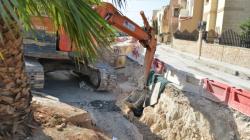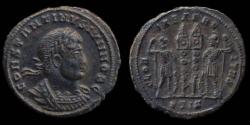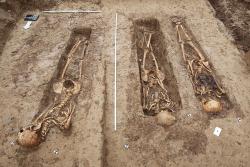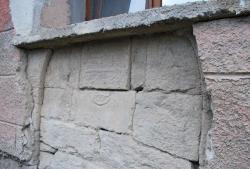INSTITUT SUPERIEUR D'ANTHROPOLOGIE
INSTITUTE OF ANTHROPOLOGY
ONLINE COURSES / COURS A DISTANCE
FALL TERM : OCTOBER 2015
REGISTER NOW
MALTE –  Rabat - Excavations works in Triq Ghajn Kejjet in Rabat have uncovered the remains of a tomb, believed to be circa 1,000 years old. The tomb may include baby remains. Witnesses on site on Wednesday afternoon told MaltaToday that works were halted as soon as the discovery work. Remains of clay vases were also found. The Superintendence of Cultural Heritage confirmed that it was currently excavating the site where the remains were found. “The discovery was made during road works in progress that where being monitored by an archaeologist under the direction of the Superintendence of Cultural Heritage,” a spokesperson said. Works in the immediate vicinity of the tomb were stopped. All necessary works are being carried out and an archaeological investigation of the tomb is currently underway, the superintendence said.
Rabat - Excavations works in Triq Ghajn Kejjet in Rabat have uncovered the remains of a tomb, believed to be circa 1,000 years old. The tomb may include baby remains. Witnesses on site on Wednesday afternoon told MaltaToday that works were halted as soon as the discovery work. Remains of clay vases were also found. The Superintendence of Cultural Heritage confirmed that it was currently excavating the site where the remains were found. “The discovery was made during road works in progress that where being monitored by an archaeologist under the direction of the Superintendence of Cultural Heritage,” a spokesperson said. Works in the immediate vicinity of the tomb were stopped. All necessary works are being carried out and an archaeological investigation of the tomb is currently underway, the superintendence said.
VIDEO = http://www.maltatoday.com.mt/arts/cultural_diary/57272/watch_tomb_excavated_in_rabat_may_include_baby_remains?#.VfwewN9Viko
GRECE –  Thessalonique - Coins found in archaeological excavations at the construction of the Thessaloniki metro revealed the ancient commercial roads that connected the city with Macedonia and the wider Black Sea area. A total of 672 coins were discovered during the excavations of the metro stations of Thessaloniki. 137 cannot be identified, 393 were issued in Thessaloniki, 47 in Rome, 13 in Antioch, 6 in Edessa of Syria, 6 in Syskia, 3 in Milan, 2 in Africa, 1 in Ravenna and 1 in Arles. The other 57 came from the regions of Propontis and the Black Sea. "These coins prove that a trade relation between Thessaloniki and other cities in the Propontis and the Black Sea had been developed in the Roman Era," assistant professor of Classical Archaeology Manolis Manoledakis said to ANA-MPA. "We are aware, from a large number of Roman sarcophagus in Thessaloniki, that some of the persons buried in the city were born in Asia Minor and Propontis," the University's professors underlined, adding that "the excavations in the metro as well as the restoration of the coins continues and we expect to find more coins from Propontis and the Black Sea that will broaden our knowledge on the communication and interaction between these areas and the city of Thessaloniki."
Thessalonique - Coins found in archaeological excavations at the construction of the Thessaloniki metro revealed the ancient commercial roads that connected the city with Macedonia and the wider Black Sea area. A total of 672 coins were discovered during the excavations of the metro stations of Thessaloniki. 137 cannot be identified, 393 were issued in Thessaloniki, 47 in Rome, 13 in Antioch, 6 in Edessa of Syria, 6 in Syskia, 3 in Milan, 2 in Africa, 1 in Ravenna and 1 in Arles. The other 57 came from the regions of Propontis and the Black Sea. "These coins prove that a trade relation between Thessaloniki and other cities in the Propontis and the Black Sea had been developed in the Roman Era," assistant professor of Classical Archaeology Manolis Manoledakis said to ANA-MPA. "We are aware, from a large number of Roman sarcophagus in Thessaloniki, that some of the persons buried in the city were born in Asia Minor and Propontis," the University's professors underlined, adding that "the excavations in the metro as well as the restoration of the coins continues and we expect to find more coins from Propontis and the Black Sea that will broaden our knowledge on the communication and interaction between these areas and the city of Thessaloniki."
http://www.sigmalive.com/en/news/greece/135301/coins-show-link-from-thessaloniki-to-black-sea-in-roman-era?
ALLEMAGNE –  Frankfort - The skeletons of 200 Napoleonic soldiers have been found during construction work in the German city of Frankfurt, officials said Thursday. "We estimate that about 200 people were buried here," said Olaf Cunitz, head of town planning for the city, at a press conference at the site in Frankfurt's western Roedelheim district. "According to our preliminary estimate, they are soldiers from the Great Army in 1813", who were on the way back from Napoleon's Russian campaign. They had fought battles that claimed 15,000 lives in areas near Frankfurt in October 1813, said Cunitz. The soldiers probably died from battle wounds or succumbed to a typhus epidemic that decimated their army at the time, said Cunitz. He said this was yet to be scientifically verified. It was certain that the "tombs were erected in an emergency," said Andrea Hampel, heritage and historic monuments director in Frankfurt. The soldiers were buried in coffins, which kept the skeletons well-preserved. They were aligned in a row, without funeral articles, in a north-south orientation, not an east-west axis as was common for European Christians at the time, suggesting they were buried in haste, said Hampel. Over 30 skeletons have been excavated and work to dig up the rest was expected to take four to six weeks, said site manager Juergen Langendorf.
Frankfort - The skeletons of 200 Napoleonic soldiers have been found during construction work in the German city of Frankfurt, officials said Thursday. "We estimate that about 200 people were buried here," said Olaf Cunitz, head of town planning for the city, at a press conference at the site in Frankfurt's western Roedelheim district. "According to our preliminary estimate, they are soldiers from the Great Army in 1813", who were on the way back from Napoleon's Russian campaign. They had fought battles that claimed 15,000 lives in areas near Frankfurt in October 1813, said Cunitz. The soldiers probably died from battle wounds or succumbed to a typhus epidemic that decimated their army at the time, said Cunitz. He said this was yet to be scientifically verified. It was certain that the "tombs were erected in an emergency," said Andrea Hampel, heritage and historic monuments director in Frankfurt. The soldiers were buried in coffins, which kept the skeletons well-preserved. They were aligned in a row, without funeral articles, in a north-south orientation, not an east-west axis as was common for European Christians at the time, suggesting they were buried in haste, said Hampel. Over 30 skeletons have been excavated and work to dig up the rest was expected to take four to six weeks, said site manager Juergen Langendorf.
http://artdaily.com/news/81538/Archaeologists-find-skeletons-of-200-Napoleonic-troops-buried-in-western-Gemany?#.VfwjxN9Viko
BULGARIE –  Zimovina - An 18th century Ottoman inscription in Turkish as well as unidentified Byzantine coins have been found in the town of Zimovina, Stambolovo Municipality, in Southern Bulgaria.The inscription was found inside one of the walls of the house of a local man, Erol Murad, reports the Bulgarian Turkish daily Zaman. The inscription written in Ottoman Turkish in the traditional Arabic alphabet mentions the date “1,200 according to Hijri”. Converted to the Gregorian Calendar, this date from the Hijri, or the Islamic Calendar, translates to 1785, i.e. the end of the 18th century AD. The town of Zimovina in Bulgaria’s Haskovo District is located in the Eastern Rhodope Mountains. It was founded in the 18th century by 11 families who settled near existing Ottoman Turkish barracks. The old Turkish name of the town means “Large Barracks”.
Zimovina - An 18th century Ottoman inscription in Turkish as well as unidentified Byzantine coins have been found in the town of Zimovina, Stambolovo Municipality, in Southern Bulgaria.The inscription was found inside one of the walls of the house of a local man, Erol Murad, reports the Bulgarian Turkish daily Zaman. The inscription written in Ottoman Turkish in the traditional Arabic alphabet mentions the date “1,200 according to Hijri”. Converted to the Gregorian Calendar, this date from the Hijri, or the Islamic Calendar, translates to 1785, i.e. the end of the 18th century AD. The town of Zimovina in Bulgaria’s Haskovo District is located in the Eastern Rhodope Mountains. It was founded in the 18th century by 11 families who settled near existing Ottoman Turkish barracks. The old Turkish name of the town means “Large Barracks”.
http://archaeologyinbulgaria.com/2015/09/17/18th-century-ottoman-turkish-inscription-byzantine-coins-found-in-bulgarias-zimovina/